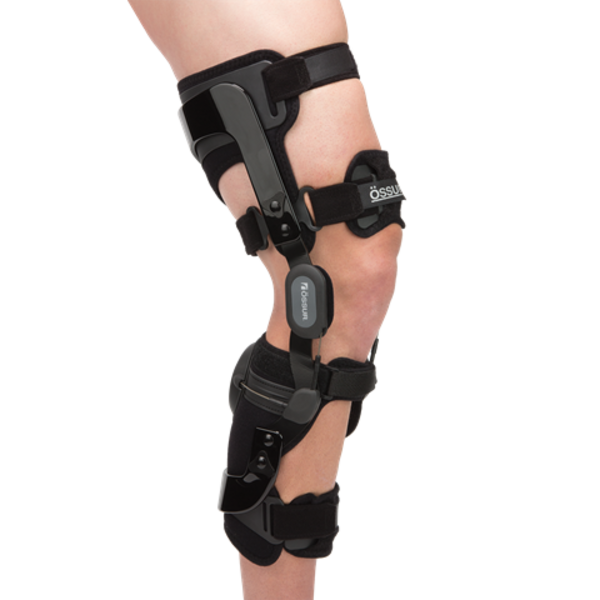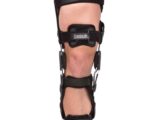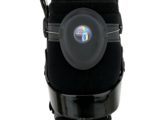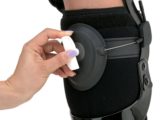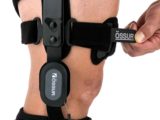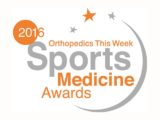Description
Indications for use
- Rehabilitation of Posterior Cruciate Ligament (PCL) ruptures, whether post-surgical reconstruction or during functional (non-surgical) treatment.
Features and benefits
- A Dynamic Tension System™ designed to increase the load on the tibia as the knee goes through flexion, providing an anterior drawer force that reduces the load on the PCL.
- Shear Knobs for specific load adaptation according to the patient’s individual anatomy and rehabilitation related requirements.
- Polycentric Hinge with extension and flexion stops allowing for range of motion adjustment.
- Anti-migration Straps (AMS) reduce migration and provide comfort while ensuring that the brace stays in correct position.
- Breathable Sensil® liners reduce migration and skin irritation while providing comfort.
Rebound® PCL Case Studies
Key opinion leaders around the world are incorporating Rebound Functional Healing products into their treatment protocols to improve patient outcomes. Read their full case studies below:
Rebound PCL Case Studies
Dr. Tobias Jung
Charité-University Medicine Berlin
39-year-old male patient with grade II-III PCL tear treated non-surgically with Rebound PCL brace and physical therapy.
45-year-old female patient with isolated PCL tear treated with PCL reconstruction with autologous hamstring tendons.
Dr. Christos Kondogiannis
Royal Melbourne Hospital St. Vincent’s Private Hospitals
24-year-old-male with right knee isolated high grade PCL injury treated non-surgically with Rebound PCL and physical therapy.
27-year-old male with ACL/PCL and MCL deficient left knee treated with autologous hamstring PCL reconstruction, autologous BPB ACL reconstruction and allograft LaPrade MCL reconstruction
Dr. Robert LaPrade
Complex Knee and Sports Medicine Surgeon, The Steadman Clinic
24-year-old male injured during a tumbling landing with severe varus noncontact injury treated with double bundle PCL reconstruction, a complete anatomic posterolateral corner knee reconstruction and a medial meniscus root repair.
Benefits of Dynamic Loading
Proven physiologic loading in knee extension and knee flexion.2
The Rebound PCL brace applies significantly larger forces at higher knee flexion angles, where the posterior cruciate ligament (PCL) is maximally loaded in vivo, compared to a static PCL brace.

-
- LaPrade RF, Smith SD, Wilson KJ, Wijdicks CA. Quantification of functional brace forces for posterior cruciate ligament injuries on the knee joint: an in vivo investigation. Knee Surg Sports Traumatol Arthrosc [Internet]. 2014 Aug 22 [cited 2014 Dec 11]; Available from: http://www.ncbi.nlm.nih.gov/pubmed/25145947
Pcl Rehabilitation Protocol
The Rebound PCL brace can be used for rehabilitation of posterior cruciate ligament (PCL) ruptures, both in functional (non-surgical) and post-surgical protocols.
| ROM – Range of motion, PWB – Partial weight bearing, FWBAT – Full weight bearing as tolerated, FWB – Full weight bearing, OKC – Open kinetic chain, CKC – Closed kinetic chain, PRICE – Protection Rest Ice Compression Elevation.
|
||||
| Phase I (1–6 weeks) | Phase II (7–12 weeks) | Phase III (13–18 weeks) | Phase IV (> 18 weeks) | |
|---|---|---|---|---|
| Rebound PCL | Day & night | Day & night | Discontinue use | |
| ROM [Ext./Flex.] |
|
|
No Limitations | No Limitations |
| Weight Bearing | PWB week 1-2 PWB → FWB |
FWB | FWB | |
| Physio |
|
|
Prepare for sport specific activity | Sports specific agility exercise |
| ROM – Range of motion, PWB – Partial weight bearing, FWBAT – Full weight bearing as tolerated, FWB – Full weight bearing, OKC – Open kinetic chain, CKC – Closed kinetic chain, PRICE – Protection Rest Ice Compression Elevation. | |||||
| Phase I (1–6 weeks) | Phase II (7–12 weeks) | Phase III (13–18 weeks) | Phase IV (19-24 weeks) | Phase V (25-36 weeks) | |
|---|---|---|---|---|---|
| Rebound PCL | Day & night | Day & night | Use for all activities | Use for all activities | Wean off as tolerated |
| ROM [Ext./Flex.] |
|
|
No Limitations | No Limitations | No Limitations |
| Weight Bearing | Non weight bearing | FWB → FWBAT | FWB | FWB | FWB |
| Physio |
|
|
|
|
|
- Pierce CM, O’Brien L, Griffin LW, LaPrade RF. Posterior cruciate ligament tears: functional and postoperative rehabilitation. Knee Surg Sports Traumatol Arthrosc [Internet]. 2013 May [cited 2014 Dec 9];21(5):1071–84. Available from: http://www.ncbi.nlm.nih.gov/pubmed/22484415
Order Information
| *Order Using Össur’s SmartMeasure iOS App | |
| Part# | Description |
|---|---|
| B-124501154 | Rebound PCL Brace Custom Right* |
| B-124501155 | Rebound PCL Brace Custom Left* |
| B-705130042 | Extension Stop Kit |
| B-705130043 | Flexion Stop Kit |
| B-465350087 | Shear Knob Kit |
| PCL00061 | S-L Strap Kit |
| PCL00062 | XL-XXL Strap Kit |
| B-705130046 | Condyle Kit |
